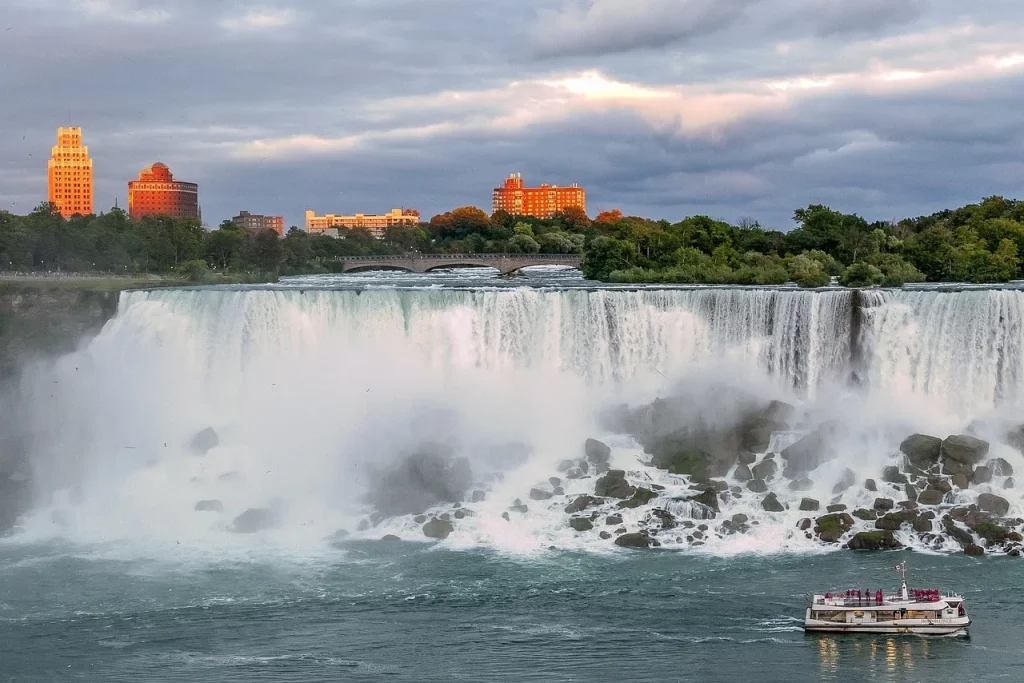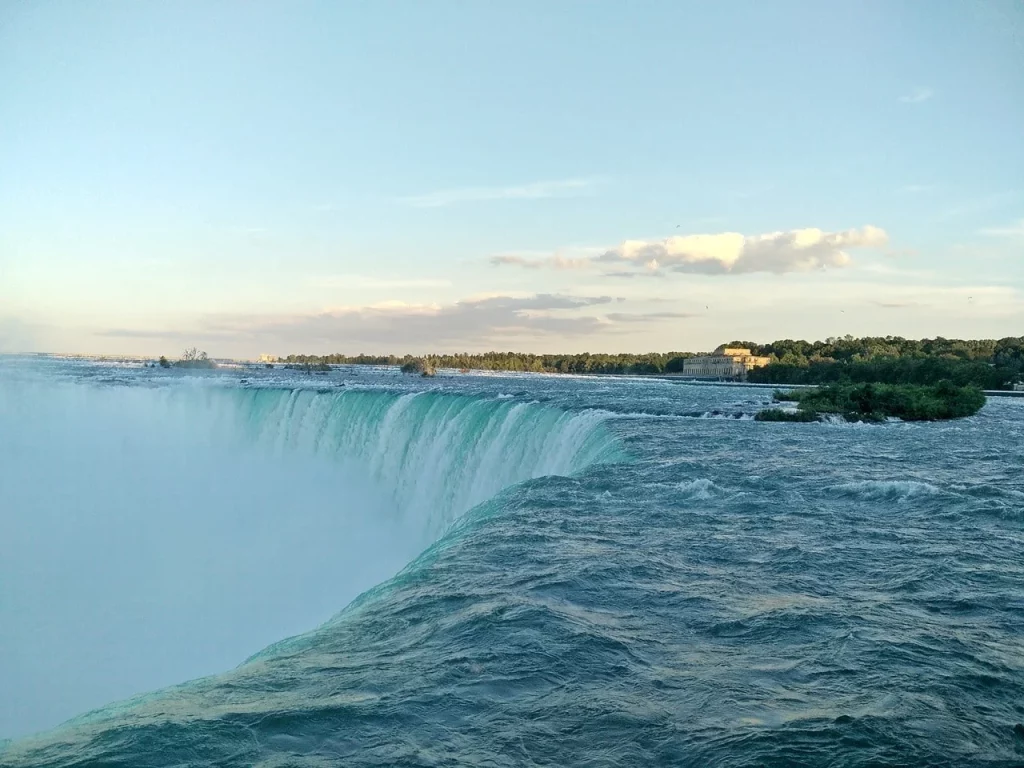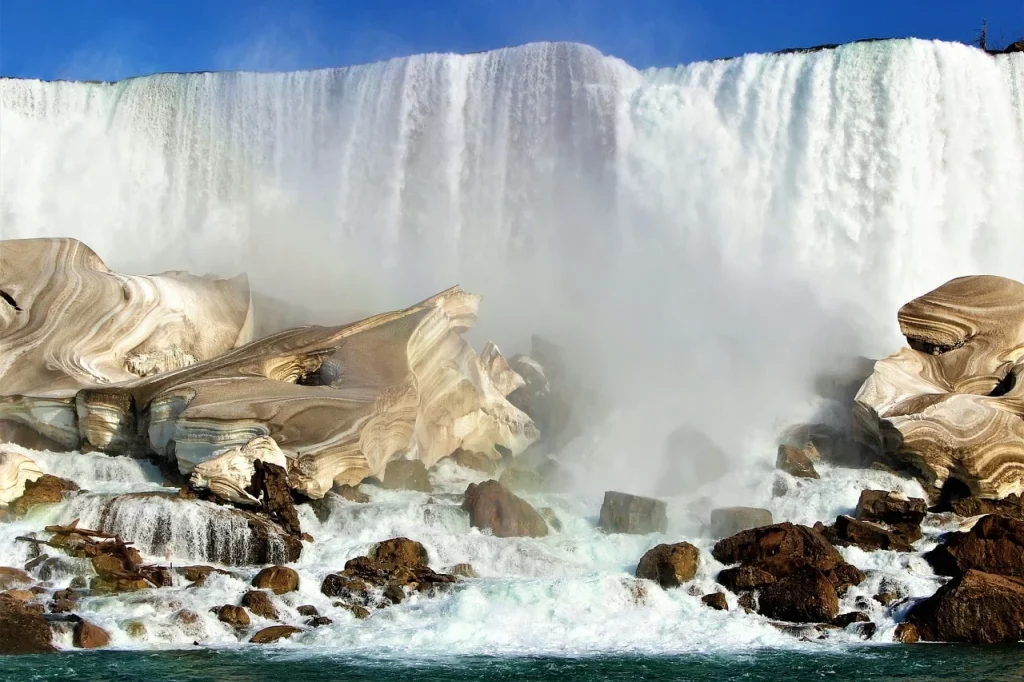What secrets lie in the mist of Niagara Falls? How has this monumental cascade influenced artists, adventurers, and leaders throughout history? In this article, we explore some astonishing facts about Niagara Falls, each revealing a layer of its immense beauty and significance.
From its geological origins to the stories of those who dared to challenge its waters, prepare to be amazed by the many facets of Niagara Falls. Let’s embark on a journey of wonder and discovery.
Niagara Falls is the hanging tongue on the face of the earth, drooling endlessly over its own beauty.
Vinita Kinra
Niagara Falls Facts
Let’s unravel the mysteries of Niagara Falls together. Make sure you pay attention to every fact, as I created a quiz for you at the end of this article. It’s your time to shine.
- Niagara Falls retreats about one foot annually due to erosion, a phenomenon known as recession.
- Annie Edson Taylor became the first individual to go over it in a barrel and survive in 1901.
- Three distinct waterfalls make up Niagara Falls: Horseshoe Falls, American Falls, and Bridal Veil Falls.
- Niagara Falls is responsible for diverting 20% of the world’s fresh water supply.
- The hydroelectric power produced by Niagara Falls benefits both the U.S. and Canada, marking it as an essential source of renewable energy for both nations.
- During the War of 1812, Niagara Falls served as a pivotal combat zone, marking its significance in North American history.
- Since 1846, the “Maid of the Mist” boat excursion has been a staple attraction, offering close encounters with the falls.
- Annually, it attracts over eight million tourists, making it one of the globe’s most visited attractions.
- The earliest photograph of Niagara Falls dates back to 1840, highlighting its long-standing allure for photographers.
- Films such as “Superman II” and “Pirates of the Caribbean: At World’s End” have featured Niagara Falls as a key location.
- The Wisconsin glaciation around 10,000 years ago is credited with the formation of Niagara Falls.
- In 2012, Nik Wallenda became the first to tightrope walk directly over the expanse of Niagara Falls.
- Visitors can explore underwater tunnels at Niagara Falls, offering a unique perspective from behind and beneath the waterfalls.

- The natural “Ice Bridge” phenomenon allows people to traverse parts of the river during the frosty winter months.
- Established in 1885, Niagara Falls State Park is recognized as the United States’ oldest state park.
- Nighttime illumination of it started in 1925, transforming it into a mesmerizing spectacle after dark.
- On average, around 3,160 tons of water cascades over Niagara Falls every second, demonstrating its immense force.
- The “Journey Behind the Falls” experience permits visitors to stand within a cavern located directly behind Horseshoe Falls.
- Contrary to popular belief, Niagara Falls never completely freezes in winter, although ice forms, water persists in flowing beneath.
- In 1969, the flow of the American Falls was temporarily halted by the U.S. for scientific examination.
- Goat Island Bridge offers exceptional views of both the American and Horseshoe Falls, connecting the mainland to Goat Island.
- Over the years, Niagara Falls has attracted stunt performers and thrill-seekers, attempting to conquer its formidable waters.
- Nearby, a vast floral clock, one of the world’s largest, represents a notable landmark adorned with thousands of blooms.
- Early 20th-century hydroelectric projects at Niagara Falls pioneered the development of green energy solutions.
- Visitors can easily access Luna Island and Bridal Veil Falls by foot for intimate views of the falls’ splendor.
- The transformation of it during winter into a landscape adorned with ice and snow offers an alternate yet equally stunning view.
- The exhilarating “Cave of the Winds” tour brings visitors face-to-face with the falls, complete with protective gear.
- Remarkably, most fish that plunge over the falls survive, cushioned by the foamy water at the base.

- Rainbows frequently adorn Niagara Falls, adding to its natural beauty and allure.
- Sustainability and environmental stewardship are emphasized through ongoing green initiatives at Niagara Falls.
- The Friendship Festival symbolizes the enduring peace and camaraderie between the U.S. and Canada, celebrated at Niagara Falls.
- The majestic falls have inspired a multitude of artists, poets, and authors, immortalizing its grandeur in various artistic forms.
- The UNESCO World Biosphere Reserve includes the “Niagara Escarpment,” pivotal in the falls’ creation.
- Niagara Falls’ iconic status has made it a favored backdrop for a wide array of cinematic and documentary endeavors.
- Named for its distinctive curve, the Horseshoe Falls are the most expansive and powerful of the trio.
- The region around Niagara Falls plays a vital role as a freshwater habitat, supporting diverse ecosystems and communities.
- Queen Victoria Park, adjacent to Niagara Falls, is a prime location for viewing the falls, especially during the nightly light shows.
- The Winter Festival of Lights transforms the area into a wonderland of light and color, celebrating the holiday season.

- Niagara Falls has historically been a catalyst for advancements in hydroelectric technology.
- A “Niagara Falls Daredevil Exhibit” chronicles the adventurous spirits who’ve braved the falls in various daring devices.
- The Great Gorge Adventure offers insights into the ancient geological forces that shaped Niagara Falls.
- The development of hydroelectric power at Niagara Falls has played a crucial role in North American energy strategies.
- Its ecological significance is underscored by its role as a habitat for a diverse array of wildlife, including birds, fish, and mammals.
- The International Rainbow Bridge provides picturesque routes between the U.S. and Canada, boasting panoramic falls views.
- The Niagara River, which feeds into the falls, serves as an important corridor for bird and fish migration.
- The sheer beauty and force of Niagara Falls serve as a poignant reminder of nature’s power and the importance of preserving natural landscapes.
- Downstream, the “Whirlpool Rapids” offer one of the globe’s most daunting challenges for whitewater enthusiasts.
- Exploring the rich history of it through guided tours reveals its significance to indigenous cultures and early explorers.
- The phenomenon known as the “Supermoon” can significantly increase the volume of water flowing over Niagara Falls, highlighting the intricate relationship between celestial events and terrestrial phenomena.
- In an effort to preserve its natural beauty, the area surrounding Niagara Falls has been designated as a protected zone, with extensive measures in place to maintain its ecological integrity and ensure the well-being of local wildlife.
Niagara Falls Myths

Transitioning from the captivating facts, we now venture into a realm where myth and reality often intertwine. Let’s embark on a journey to distinguish the myths from the truths that surround this natural wonder.
- Niagara Falls Can Freeze Solid in Winter
While it might look like Niagara Falls turns into a frozen wonderland during the harshest winter months, the truth is, the water never completely stops flowing. Under the icy exterior, water continues to rush over the falls. The immense volume and flow rate make it nearly impossible for the entire falls to freeze solid. - Niagara Falls is the Tallest Waterfall in the World
Niagara Falls is indeed spectacular, but it doesn’t hold the title for the tallest waterfall. That honor goes to Angel Falls in Venezuela, which boasts a height of over 3,200 feet. Niagara Falls, with its highest drop of about 167 feet, is renowned more for its impressive width and volume. - Barrel Rides Over the Falls Are a Common Stunt
Despite the famous stories of daredevils braving the falls in barrels, such stunts are rare and highly illegal. These events have occurred only a handful of times and are strongly discouraged due to the extreme danger involved. The majority of visitors wisely choose to enjoy the falls from the safety of observation areas. - Niagara Falls is a Single Waterfall
Many believe Niagara Falls to be one giant waterfall, but it’s actually comprised of three distinct falls: Horseshoe Falls, American Falls, and Bridal Veil Falls. Each contributes to the overall majesty of Niagara Falls, creating a breathtaking panorama that straddles the border between the United States and Canada. - The Niagara Falls Were Discovered by Europeans in the 17th Century
While European explorers did document it in the 17th century, Indigenous peoples had known and lived around the falls for thousands of years prior. The falls were not “discovered” in the true sense but rather introduced to European awareness, acknowledging the rich history and culture of the Indigenous peoples who were the original stewards of the land.
Niagara Falls Quotes

Let’s continue our majestic journey with the next section. Here you will find my list of favorite quotes about this natural wonder. Feel free to share yours in the comments so I can put them on the list as well.
Niagara Falls is first rate… It is the second greatest disappointment in American married life.
Oscar Wilde
Oscar Wilde, with his characteristic wit, juxtaposes the majesty of Niagara Falls against the often unrealistic expectations of married life.
Niagara… most powerful waterfall in North America and possibly the best-known in the world.
Patricia Schultz
Patricia Schultz acknowledges Niagara Falls not just for its sheer power but also for its iconic status across the globe.
The vastness of Niagara… echoes of the sublime.
Charles Dickens
Charles Dickens captures the overwhelming and awe-inspiring impact of Niagara Falls, associating it with the profound beauty of the sublime.
Niagara Falls is a magnificent work of nature that one should see in their lifetime.
Nikola Tesla
Nikola Tesla, renowned for his contributions to the development of electricity generated at Niagara Falls, emphasizes the falls as a wonder of nature worth witnessing.
Every American bride is taken there, and the sight of the stupendous waterfall must be one of the earliest, if not the keenest, disappointments in American married life.
Oscar Wilde
Oscar Wilde humorously critiques the tradition of visiting Niagara Falls as a honeymoon destination, suggesting it might not live up to its romantic expectations.
Niagara Falls FAQ

As we transition from the inspiring quotes about Niagara Falls, we approach the final section of our journey: the FAQ section. Read carefully, as this is your last stop before the quiz that follows.
- Why was Niagara Falls dry in 1969?
In 1969, Niagara Falls wasn’t exactly dry, but the American side of the falls was intentionally diverted for several months. The reason? Scientists wanted to study the rock face and the effects of erosion. They also wanted to remove any loose rocks that might pose a danger. It was a rare sight, with the water flow stopped by a temporary dam, giving researchers a unique opportunity to examine the falls’ geological composition. - How was Niagara Falls formed?
Niagara Falls was formed around 12,000 years ago, at the end of the Ice Age. When the glaciers began to melt, vast amounts of water were released into the Niagara River, carving out the falls as we know them today. This process created the dramatic landscapes of the Niagara Gorge and the falls themselves, with water from the Great Lakes plunging over the Niagara Escarpment. - Can Niagara Falls be turned off?
While it sounds like a plot from a sci-fi movie, parts of Niagara Falls can indeed be “turned off” to some extent. This has been done in the past for maintenance and research purposes. For example, in 1969, the American Falls were diverted for geological studies. However, completely stopping the entire falls, which include the American Falls, Bridal Veil Falls, and Horseshoe Falls, would be a massive undertaking and is not feasible for long-term purposes. - Why is Niagara Falls a wonder of the world?
Niagara Falls is often celebrated as a wonder of the world because of its breathtaking beauty and immense power. It’s one of the largest waterfalls by flow rate, showcasing an awe-inspiring display of nature’s force. The falls have captivated people for centuries, not just for their natural beauty but also for their significance in hydroelectric power development and conservation efforts. - What’s the best time to visit Niagara Falls?
The best time to visit depends on what you’re looking for. Summer (June to August) offers warm weather and the full range of attractions and tours, making it the most popular season. However, it’s also the most crowded. Spring and fall provide cooler weather and fewer crowds, with the beauty of the falls accentuated by blooming flowers or autumn leaves. Winter has its charm too, with the falls surrounded by ice formations, though some attractions may be closed.
Niagara Falls Trivia

Dive into our Niagara Falls quiz, but beware: if you don’t get any questions right, you might just find yourself going over the falls in a barrel of ignorance!
Conclusion
As our exploration comes to a close, we’re left with a sense of profound appreciation for one of nature’s most spectacular displays. The falls remind us of the power of nature to shape our world, our cultures, and our imaginations.
Whether it’s the thrill of seeing the water crash down from great heights, the history that surrounds the area, or the peaceful moments of beauty that await around every corner, Niagara Falls has something for everyone. It’s a place where nature speaks, and we’re wise to listen.
As you turn the page from this adventure, keep the spirit of Niagara in your heart and its roar in your ears. Till next time, stay curious.
6 Sources Used For This ArticleNiagara Falls, New York – Wikimapia
Fun Facts About Niagara Falls Usa – Niagara Falls Usa
Niagara Falls National Heritage Area, New York – Legends Of America
Facts About Niagara Falls – Niagara Falls Live
These Photos Show Niagara Falls Without Water – Rare Historical Photos


